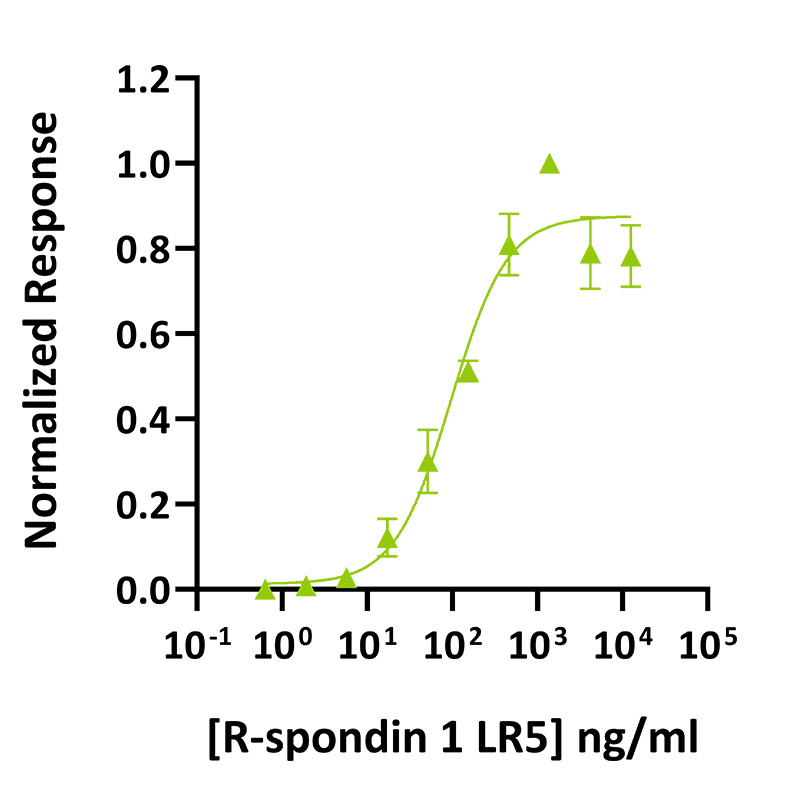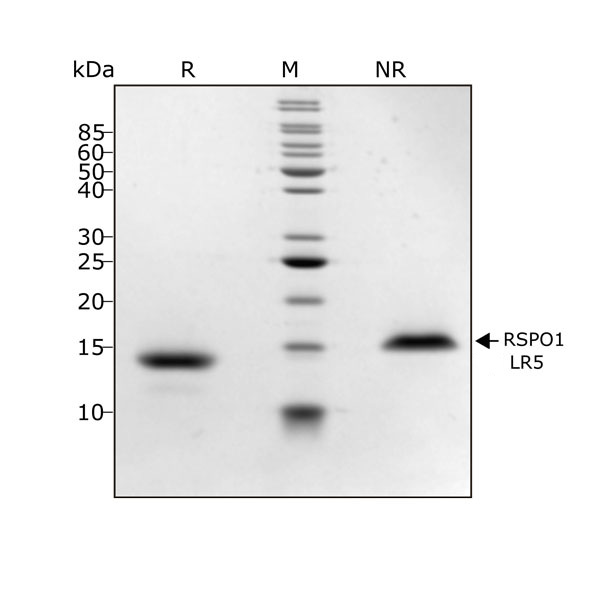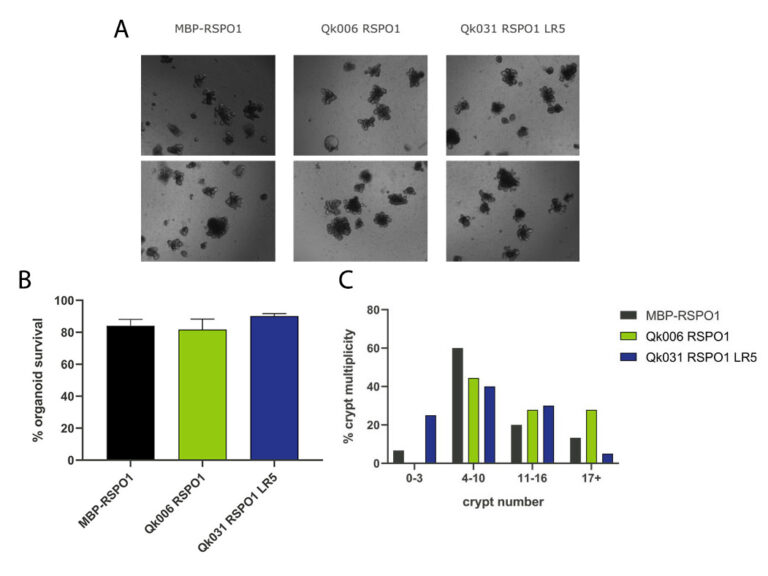 Recombinant human R-spondin 1 LR5 protein (Qk031)
Recombinant human R-spondin 1 LR5 protein (Qk031)Recombinant human R-spondin 1 LR5 protein (Qk031)
Price range: £175.00 through £1,900.00
Recombinant human R-spondin 1 LR5 protein is engineered to act as a high affinity ligand for the LGR5 receptor. In epithelial tissues LGR5 marks the stem cell population. This engineered protein, R-spondin 1 LR5, activates Wnt signaling only in the LGR5+ stem cell population.
R-spondin 1 LR5 has been tested in intestinal organoid culture and supports organoid survival and growth. As LGR5 specifically marks stem cells and is not found on transit amplifying cells, the lower crypt multiplicity seen in organoid cultures with R-spondin 1 LR5 (in comparison to wild-type R-spondin 1, Qk006) supports the notion that this engineered form is acting specifically on stem cells. This specialized form of R-spondin 1 was developed in Marc de la Roche’s lab (University of Cambridge).
In stock
Orders are typically shipped same or next day (except Friday).
Easy world-wide ordering, direct or through our distributors.
Price range: £175.00 through £1,900.00
Buy online with secure credit card or purchase order. For any questions, please email orders@qkine.com
Summary:
- High purity recombinant human R-spondin 1 LR5 protein. Binds with high affinity to LGR5 receptor.
- 13 kDa
>98%, by SDS-PAGE quantitative densitometry
Expressed in E. coli
Animal origin-free (AOF) and carrier protein-free
Manufactured in our Cambridge, UK laboratories
Lyophilized from acetonitrile, TFA
- Resuspend in 10 mM HCl (Reconstitution solution A) at >50 µg/ml, add carrier protein if desired, prepare single-use aliquots and store frozen at -20 °C (short-term) or -80 °C (long-term)
Featured applications:
Intestinal organoid culture
Tumor organoid culture

R-spondin 1 enhances Wnt signalling in TOP-Flash reporter assay. HEK293T cells transfected with Wnt-responsive firefly luciferase reporter TOP-FLASH were treated with increasing concentrations of Qk031 R-spondin 1 LR5 (diluted in DMEM with 0.5 % of FCS), in the presence of Wnt-conditioned media (1:8 dilution), in triplicate. Cells were grown overnight and luciferase activity measured by luminescence. Data from Qk031 lot #204574. EC50 = 97 ng/ml (7.7 nM).
R-spondin 1 LR5 migrates as a single band at 16 kDa in non-reducing (NR) and 13 kDa in reducing (R) conditions. Purified recombinant protein (1 µg) was resolved using 15% w/v SDS-PAGE in reduced (+β-mercaptothanol, R) and non-reduced conditions (NR) and stained with Coomassie Brilliant Blue R250. Data from Qk031 lot #104286.

Further quality assays
Mass spectrometry: single species with expected mass
Recovery from stock vial: >95%
Endotoxin: <0.005 EU/μg protein (below level of detection)
We are a company founded and run by scientists to provide a service and support innovation in stem cell biology and regenerative medicine. All our products are exceptionally high purity, with complete characterisation and bioactivity analysis on every lot.

Qk031 is a specialized form of R-spondin 1 that specifically binds to the LGR5 receptor, which was developed in the lab of Marc de la Roche (University of Cambridge). R-spondin 1 (Qk006) is a ligand for the leucine-rich repeat-containing G-protein coupled receptors (LGR) 4-6. Binding of R-spondin 1 to its coreceptors, LGR4-6 and ZNRF3, releases the inhibition ZNRF3 imposes on Wnt signalling.
In epithelial tissues LGR5 marks the stem cell population. This engineered form, R-spondin1 LR5, activates Wnt signalling only in the LGR5+ stem cell population.
Protein background
Human R-spondin 1 (RSPO-1) protein is a secreted activator of the canonical Wnt signaling pathway. A ligand for the leucine-rich repeat-containing G-protein coupled receptors (LGR) 4-6 [1], recombinant R-spondin 1 protein is used extensively in adult stem cell-derived organoid culture, intestinal organoid culture, hematopoietic stem cell specification and other iPSC and culture systems [1-5] .
Qk031 is an engineered form of R-spondin 1 with higher affinity for the LGR5 receptor and lower affinity for LGR4. The aim is to specifically target Wnt-3a signalling in the LGR5+ stem cell population in intestinal organoids.
Qk006 recombinant human R-spondin 1 protein is a highly pure biologically active fragment comprising two cysteine-rich, furin-like domains – the essential domains for activity in stem cell culture. Our E. coli-produced recombinant R-spondin 1 protein is not glycosylated, which ensures reliable production of homogeneous protein and enhanced comparability between batches. The glycosylation of R-spondin 1 protein is not necessary for extracellular signalling and stability [6].
Customer & collaborator data
Recombinant human R-spondin 1 LR5 protein support organoid survival and growth in intestinal organoid culture. As LGR5 specifically marks stem cells and is not found on transit amplifying cells, lower crypt multiplicity is seen in organoid cultures with R-spondin1 LR5 (in comparison with WT R-spondin 1), which supports the notion that this engineered form is acting specifically on stem cells. Mouse intestinal organoid morphology is healthy in cultured maintained in R-spondin 1 LR5 (A). Intestinal organoid survival is maintained in R-spondin 1 LR5 cultures (B). Lower crypt multiplicity is observed suggesting targeting of LGR5+ stem cell population (C).
All organoid data from the laboratory of Marc de la Roche (University of Cambridge) and reproduced with permission (© Marc de la Roche, 2020).
This is part of our pioneering proteins range where the full range of activities and applications of this novel protein have not been determined.

FAQ
R-spondin 1 regulates Wnt signaling and β-Catenin stabilization. Therefore, the functions of R-spondin 1 are diverse and are associated with cell proliferation and differentiation. It maintains the self-renewal capacity of stem cells and is involved in the embryonic development especially the development of the female reproductive system, gastrointestinal track, and neural tube.
The Wnt signaling pathway is involved in in various biological processes. It is involved in the cell fate specification, embryonic development, stem cell maintenance, tissue regeneration, synaptic function, immune response, cancer progression, and cell migration.
The molecular weight is 13 kDa.
The RSPO1 gene provides instructions for producing the R-spondin 1 protein.
The RSPO1 gene is located at 1q41.2.
It is a growth factor supplemented to cell culture media. It is used for the culture of induced pluripotent stem cells, embryonic stem cells, epithelial stem cells, and organoids such as intestinal and colon organoids.
The size of the R-spondin proteins, including R-spondin 1 (RSPO1), can vary slightly depending on the specific isoform and the species being considered. In humans, RSPO1 is approximatively 263 amino acids in length with a molecular weight of 13-29 kDa.
Our products are for research use only and not for diagnostic or therapeutic use. Products are not for resale.
For use in manufacturing of cellular or gene therapy products. Not intended for in vivo applications.

Receive an Amazon gift voucher when you leave us a review.
£25, $30 or €30 for reviews with an image and £10, $15 or €15 for reviews without an image
